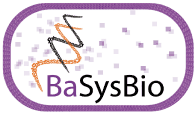
WP 1.1 - Chromosome engineering and living cell array
Leader : Pr Anthony Wilkinson
Workpackage leader: University of York, Pr. Anthony Wilkinson
WP1.1 will generate biological material and chromosome engineering toolbox:
-
Genome-wide cell array in which each promoter-containing intergenic region controls the expression of a fluorescent reporter protein to monitor real time promoter activity in living cells;
-
Molecular toolbox enabling efficient tagging and production of proteins from B. subtilis and related pathogenic Gram-positive bacteria;
-
Collection of strains in which transcription factors (TF) are epitope-tagged.
As part of WP1.1, a major innovation in BaSysBio will be the construction of a cell array at an unprecedented scale. The cell array will be composed of ~1500 strains in which promoter-containing intergenic regions will control the expression of a fluorescent reporter protein. The measurement of fluorescence accumulation in a cell population (Ronen et al. , 2002; Zaslaver et al. , 2004) or in individual cells (Friedman et al. , 2005; Rosenfeld et al. , 2005) allows to determine promoter activities in a time-resolved fashion. Promoter activity drives RNA synthesis and the RNA accumulation measured using DNA microarrays reflects the equilibrium between RNA synthesis and degradation. Thus, the combination of both DNA microarrays and live cell arrays will facilitate the identification of novel regulatory mechanisms at a systems level. Whilst complementing DNA microarray work, the cell array has additional advantages/capabilities. Most importantly, cell arrays can be used to monitor promoter activity in single cells, offering the possibility to visualise dynamic fluctuations in individual cells and can reveal heterogeneity in cell populations. This information can be integrated with proteomic data ( e.g. amounts of transcription factors) to elucidate regulatory circuits (Rosenfeld et al. , 2005). Because cell arrays can be operated at a much lower cost than DNA microarrays, a greater range of conditions can be explored. As the main advantage of the cell arrays, short time intervals are accessible to build a high resolution profile of transcription dynamics that cannot be obtained from DNA microarray methods.
The cell array will be complemented by strains producing epitope-tagged transcription factors whose effector and DNA binding characteristics will be analysed under the Biology Pillar together with studies of protein-protein interactions and in selected cases for protein localisation studies.